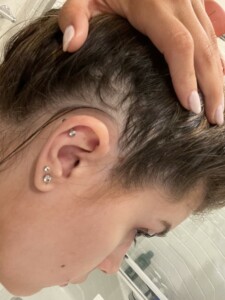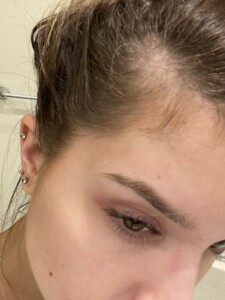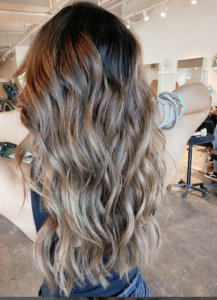Let’s talk extensions! Love ‘em, hate ‘em… wanna try ‘em? I originally invested in extensions due to some pretty extreme postpartum hair loss, and it was during that time that I turned to extensions to help fill in the (literal) gaps. Let me show you what I mean.


My hair loss was so bad that I had bald spots around my head. I was so embarrassed by my hair that I have almost a year of pictures where I am missing. I was desperate to find a way back to something that felt like “me,” so I pursued extensions.
Extensions can elevate your hair in two ways: adding LENGTH and increasing VOLUME. Extra length seems to be the most common reason people look into getting extensions, but plenty of people with bobs add a row or two for fullness or to help with growth in certain places.

I’ve had hair extensions on and off for several years now, and I’ve tried all the different methods, such as tape ins and clip ins. But after much trial and error, I’ve found that the beaded row method (also called natural beaded row) is the safest and works the best for me. This method involves hand tying the hair in, so there’s no glue, tape, or harsh chemicals involved. It causes the least damage possible, and I feel like it’s almost protective of my own natural hair growth. I recommend always reaching out to specialists in your area before booking an appointment anywhere, and do your research using tags on insta such as #[yourcity]handtied or #[yourcity]handtied extensions or #[yourcity]extensions.

Let me also say that extensions are a luxury. There’s no way around it – if you want quality extensions that won’t damage your hair, it comes with a higher price tag. I often get asked questions about pricing, but there are so many factors, such as local prices, stylists’ preference on brand of hair, length of extensions, rows needed to achieve the look, number of wefts per row, and color services that might come with it. Talk with your local stylist for pricing specific to you.
Hair extensions will usually last 6-8 months with average use when installed correctly, but they can be used up to a year or more with a good hair routine. If you decide to take the plunge, here are some tips for making your extensions last as long as possible.
- Always use salon grade products on your extensions. Moisture is key to keeping your extensions fresh since they are not attached to your scalp and don’t receive the natural oils that flow down the hair shaft. Talk to your stylist about what you should use on your hair during your appointment, or check out some of my favorites.
- Oiling your ends every night with a lightweight oil helps add moisture on a daily basis. I like the Elixir Ultime L’Huile Original Argan Hair Oil Treatment.
- Always use heat protection with any and all heat tools, including blow dryers, curlers, and straighteners. Extensions tend to hold style really well, which is a plus because heat use is minimized on your hair. Amika has a great one!
- Hair must always be dried thoroughly. Do not go to bed with your extensions damp, especially at the base. This can cause matting and in severe cases mold. Always separate the hair at every weft and dry in layers depending on how many rows you have.
- Wear your hair in a protective style to bed. A loose low ponytail (use one of these scrunchies) is plenty, but a braid is best (plus it adds some waves to your hair).
Bonus tip: My favorite way to protect my hair overnight is to use a claw clip on top of my head. This has the added benefit of saving my curls and further reduces the need for heat tools. - Sleep on a silk pillowcase or bonnet to reduce friction. Satin is slick, and the hair will slip and slide on it. Cotton is great, but it can be rough on hair. If you prefer to use cotton pillow cases, invest in a silk bonnet as an alternative.
- Always be on time with your services. The best way to protect your own hair is to make sure too much time doesn’t pass between your appointments. The rows will grow out with your natural hair, so steady move ups are a must to protect your hair from matting and reduce tension on the beaded points.
Lastly, if you ever have questions or concerns, always reach out to your stylist. In my experience, they are always happy and willing to work with you and educate you throughout this process. Good luck!
